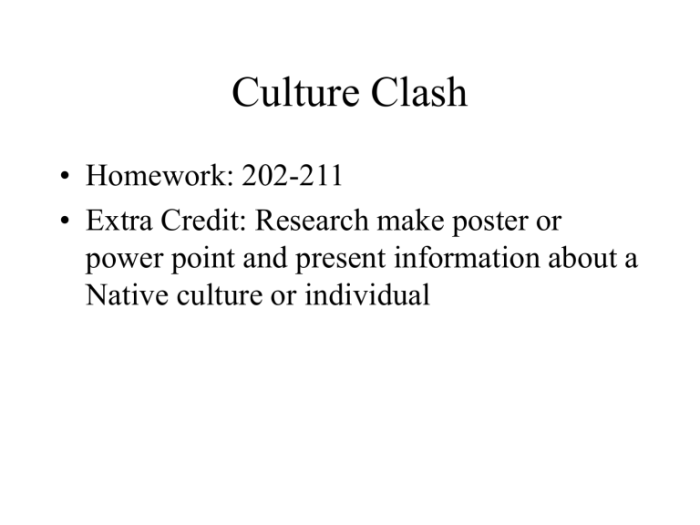In the realm of human history, the collision of cultures has played a pivotal role in shaping civilizations, fostering innovation, and generating both conflict and harmony. The Collision of Cultures Chapter 1 embarks on an enthralling journey to uncover the intricacies of cultural encounters, their profound impact on individuals and societies, and the strategies for navigating the challenges and reaping the rewards of intercultural exchange.
This chapter delves into the historical significance of cultural collisions, exploring major encounters that have left an indelible mark on world events. It examines the key differences and similarities between various cultures, highlighting the influence of language, customs, beliefs, and values on cultural identity.
The chapter also explores the concept of culture shock and its effects on individuals, as well as the process of acculturation and the challenges it presents.
Historical Context of Cultural Collisions

Throughout history, cultural encounters and clashes have played a significant role in shaping world events. These collisions have led to both positive and negative outcomes, from the exchange of ideas and innovations to conflict and bloodshed.
Major Cultural Collisions
- The Silk Road: This ancient trade route facilitated the exchange of goods, ideas, and cultures between China and the West.
- The Crusades: These religious wars between Christians and Muslims had a profound impact on the Middle East and Europe.
- The Age of Exploration: European voyages of discovery brought them into contact with new cultures and led to colonization and imperialism.
- The Cold War: The ideological conflict between the United States and the Soviet Union divided the world and influenced cultural development.
Causes and Consequences
Cultural collisions can be caused by a variety of factors, including trade, migration, war, and globalization. The consequences of these collisions can be both positive and negative, including:
- Positive:Cultural exchange, innovation, economic growth, and increased understanding.
- Negative:Conflict, prejudice, discrimination, and cultural loss.
Cultural Differences and Similarities

Every culture has its own unique set of customs, beliefs, values, and language. These differences can be a source of fascination and intrigue, but they can also lead to misunderstandings and conflict.
Key Differences
- Language:Language is a fundamental aspect of culture, and it can be a major barrier to communication between people from different cultures.
- Customs:Customs are the unwritten rules that govern behavior within a culture. They can vary widely from one culture to another.
- Beliefs:Beliefs are the fundamental assumptions that people hold about the world. They can be religious, philosophical, or political.
- Values:Values are the principles that guide people’s behavior. They can be individual or cultural.
Similarities
Despite their differences, all cultures share some fundamental similarities. These similarities include:
- The need for social connection:Humans are social beings, and we all need to connect with others.
- The desire for meaning and purpose:We all want to find meaning and purpose in our lives.
- The capacity for empathy:We all have the ability to understand and share the feelings of others.
Culture Shock and Acculturation

When people from different cultures come into contact, they may experience culture shock. Culture shock is a feeling of disorientation and confusion that can be caused by the unfamiliar customs, beliefs, and values of a new culture.
Effects of Culture Shock
- Emotional:Anxiety, depression, homesickness, and irritability.
- Physical:Headaches, stomach problems, and sleep disturbances.
- Cognitive:Confusion, difficulty concentrating, and memory problems.
- Behavioral:Withdrawal, avoidance of social situations, and difficulty adjusting to new routines.
Acculturation, The collision of cultures chapter 1
Acculturation is the process of adapting to a new culture. It can be a challenging process, but it is essential for successful integration into a new society.
Strategies for Coping with Culture Shock
- Be open-minded:Be willing to learn about the new culture and its customs.
- Seek support:Connect with others from your own culture or with people who have experience living in the new culture.
- Practice self-care:Take care of your physical and mental health.
- Give yourself time:Acculturation takes time. Don’t expect to adjust overnight.
Key Questions Answered: The Collision Of Cultures Chapter 1
What is the significance of cultural collisions?
Cultural collisions can lead to both positive and negative outcomes. On the one hand, they can foster cultural exchange, innovation, and hybridity. On the other hand, they can also lead to conflict and misunderstanding.
How can we navigate cultural differences effectively?
To navigate cultural differences effectively, it is important to be open-minded, empathetic, and willing to learn about other cultures. It is also important to be respectful of other cultures, even if they differ from our own.
What is the role of cultural sensitivity in intercultural interactions?
Cultural sensitivity is essential for successful intercultural interactions. It involves being aware of and respectful of the cultural differences between people. Cultural sensitivity can help to prevent misunderstandings and conflict, and it can foster understanding and cooperation.